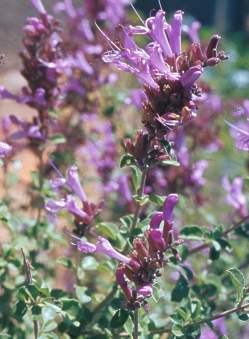Syncolostemon rotundifolius
Syncolostemon rotundifolius E.Mey. ex Benth.
Family: Lamiaceae
Common names: rounded-leaf sagebush, round-leaved pink plume
Introduction
Even if a little difficult in cultivation, this little known member of the sage family, once established, will enhance the garden with its masses of pretty pink flowers.
Description
Description
The round-leaved pink plume with stems that are velvety white, forms an open bush up to 1.8 m tall. The smallish round leaves are an attractive greenish grey. The delicate pink flowers appear from September to April in fairly dense, branched inflorescences.
Conservation Status
Status
The conservation status of this plant is considered to be lower risk, but it is considered rare due to its narrow distribution range.
Distribution and habitat
Distribution description
This plant is found only in the area known as Pondoland, which stretches from the Oribi flats in southern KwaZulu-Natal to the Port St. John's area of the Eastern Cape. It grows in the coastal grassland on rocky slopes, often near forest margins.
The climate of this area is subtropical and therefore never experiences low temperatures. Rainfall is mainly in the summer, although some rain can be expected every month of the year.
Derivation of name and historical aspects
History
This shrub belongs to the Lamiaceae or sage family, which includes many important herbs such as mint and sage. Many members of this family are highly aromatic and have square stems.
Other South African plants that belong to this family are Plectranthus and Salvia.
The name Syncolostemon refers to the shape and size filaments in the flower and rotundifolius means round leaves. The genus Syncolostemon has been enlarged to cover Hemizygia and includes several species giving colour to the garden.
Uses
Use
It has no known traditional value but is a close relative to S. densiflorus, which is used traditionally as a love-charm emetic. Grown singly or in masses S. rotundifolius is a beautiful and attractive landscape plant, especially when in flower.
Growing Syncolostemon rotundifolius
Grow
This plant grows well in full sun conditions. It needs a well-drained soil, although soil should not dry out. Most soils are good for the cultivation of Syncolostemon, but it appears to enjoy the KwaZulu-Natal loamy soil.
Use this plant as a low to medium height filler shrub in perennial borders or as an accent specimen on a rockery. Once established, do not cultivate under the plants as it does not like the soil at its roots to be disturbed. Mulching with leaves, compost, bark or even pebbles improves the growth of the plants.
Propagation of this plant is not easy although plants can be grown from seed or tip cuttings taken in August. Root the 50 mm tip cuttings in sand under mist conditions with bottom heat. A good rooting hormone should also be used. Sow the seed in seed trays filled with a well-drained commercial seedling mix and keep them in a lightly shaded spot where they will not dry out.
The shrub must be pruned every second year in early spring to prevent it becoming woody and to encourage new growth. New branches need to be tipped in late October to encourage new shoots and enhance flowering.
References
- Codd, L.E. 1985. Lamiaceae. Flora of southern Africa 28,4. Botanical Research Institute, Pretoria.
- Germishuizen, G. & Meyer, N.L. 2003. Plants of southern Africa : an annotated checklist. Strelitzia 14. National Botanical Institute, Pretoria.
- Pooley, E. 1998. A field guide to wild flowers: KwaZulu-Natal and the eastern region, Natal Flora Publications Trust, Durban.
- Scott-Shaw, R. 1999. Rare and threatened plants of KwaZulu-Natal and neighboring regions. Botanical Society, Pietermaritzaburg.
Credits
Karen Moodley
KwaZulu-Natal National Botanical Garden
October 2005
Plant Attributes:
Plant Type: Shrub
SA Distribution: Eastern Cape, KwaZulu-Natal
Soil type: Sandy, Clay, Loam
Flowering season: Late Summer
PH: Acid, Neutral
Flower colour: Pink, Mauve/Lilac
Aspect: Full Sun
Gardening skill: Average
Special Features:
Horticultural zones













Rate this article
Article well written and informative
Rate this plant
Is this an interesting plant?
Login to add your Comment
Back to topNot registered yet? Click here to register.